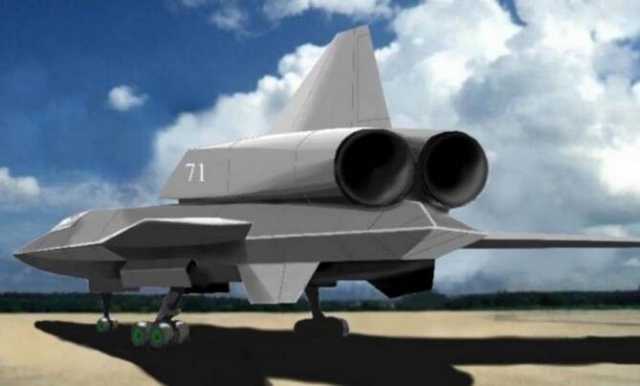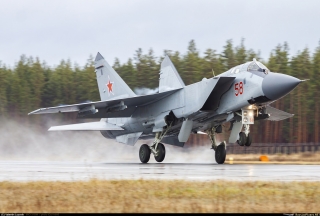 Rostec confirms development of the PAK-DP
Rostec confirms development of the PAK-DP
In January 2021, the State corporation Rostec announced that the future replacement of the MiG-31 long range interceptor, the PAK-DP project, has now entered the development phase.
The PAK-DP (perspective airborne complex for long-range interception), sometimes also (most likely erroneously) called the MiG-41, shall be a stealthy heavy interceptor aircraft which is intended to replace the MiG-31 in the Russian Federation - Aerospace Forces (RF VKS) in the late twenties.
Any official announcements mentioning this programme are extraordinarily rare. Some analysts describe the PAK-DP as a 5+ (or 6th) generation project, depending on how the criteria for the respective generations are being set. The PAK-DP is also envisioned as an interceptor of future hypersonic missiles. For that role it shall carry a multi-functional long-range interceptor missile system (MPKR-DP) that will fire missiles equipped with multiple aerodynamic bodies which will disperse into a cloud in order to increase the chance of a successful interception. Finally, the aircraft is also intended to carry specialized anti-satellite missiles.
According to the available information, the preliminary research works were finished by the end of 2019 and multiple layouts of the PAK-DP were presented. In 2020, the Russian Ministry of Defence selected the most promising project. Less is known about the design of the aircraft but the general director of the MiG and Sukhoi company, Ilya Tarasenko, mentioned in an interview in July 2020, that the PAK-DP would be created on the basis of the design of the MiG-31. The aircraft should be optionally manned and specially adapted for use in wide low temperature areas of the Arctic.
The layout and design works on the PAK-DP interceptor were based on the previous Mikoyan projects from mid ninetees, namely Projekt Maksimum with two designs (Izdeliye 3.01 interceptor and Izdeliye 3.21 bomber), both using variable geometry wings and deployable canards. The primary mission of the aircraft has remained the same – long range interception of approaching (future) bombers and reconnaissance aircraft. For this mission, speeds exceeding Mach 4 were announced which would, in turn, require use of engines suitable for such speeds. That is because the practical limit for conventional turbojet engines is at about Mach 3.5. The airflow at such speeds makes the use of a compressor completely unnecessary, therefore a completely new kind of engine had to be devised if the plane was to reach higher speeds – either a ramjet using shockwaves to compress the air before ignition or a turboramjet, basically a turbojet and a ramjet housed under the same cowling, with the airflow redirected by a separator.
The turboramjet solution has been proposed under the Projekt Maksimum and designated as D-102. These engines would be able to switch into the ramjet mode in order to maintain the maximum cruise speeds of Mach 4+ for relatively long periods of time. However, such dual-purpose engines would most likely be too massive for fitment in the fuselage, therefore in all design iterations of the future interceptor they were mounted on top of the rear section of the aircraft, giving it a distinct Tu-22 Blinder-style look. Nevertheless, the final layout of the machine has never been revealed and all presented renders are a pure speculation.
 A later Mikoyan’s project, the Izdeliye 7.01, led to many simplifications of the Izd.3.01, the most distinctive being simple delta-shaped wings and deletion of the dual-purpose turboramjets. This led to limitations of the maximum speed to values below Mach 3 which was still deemed sufficient to replace the MiG-31 in its long-range role. The lack of nearly hypersonic speeds was thought to be balanced out by a new generation of A-A missiles, based on the Mach 6 hypersonic design R-37M (RVV-BD) with the range up to 400 kilometres.
A later Mikoyan’s project, the Izdeliye 7.01, led to many simplifications of the Izd.3.01, the most distinctive being simple delta-shaped wings and deletion of the dual-purpose turboramjets. This led to limitations of the maximum speed to values below Mach 3 which was still deemed sufficient to replace the MiG-31 in its long-range role. The lack of nearly hypersonic speeds was thought to be balanced out by a new generation of A-A missiles, based on the Mach 6 hypersonic design R-37M (RVV-BD) with the range up to 400 kilometres.
Based on the remarks of Mr. Tarasenko, we believe that this is exactly the direction the design of the new MiG has been going. A substantial increase in speed for the carrier aircraft would result in radical technological challenges combined with extremely high costs which might not be justified in today’s situation.
As a Scramble’s Magazine take on the situation, we don’t expect a hypersonic design, let alone a spaceplane. Instead, we anticipate the PAK-DP to be a low observable design which surpasses today’s capabilities of the MiG-31BM especially in terms of detection capabilities, as well as maximum speed and launch range of new hypersonic weaponry, capable to plug gaps in the air defence of vast areas of Russia. The construction also should be modular enough for future versions of the aicraft to be modified to perform loyal-wingman-type unmanned missions. On top of that, an introduction in the late twenties is very optimistic.


